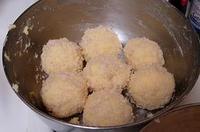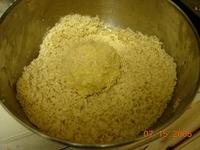
The summer months bring ice cream and sorbets to the forefront of everyones minds. Over the past few weeks, I have prepared several ice creams and sorbets, including my previous post on watermelon sorbet.
Therefore, I have decided to post my favorite (
Ginger Ice Cream), my husbands favorite (
Cherry Vanilla Ice Cream), our favorite 'once in a while' ice cream (
Basil Ice Cream) and the o'stand by (
Vanilla Ice Cream).
Making Ice Cream is a lot easier than people would assume, it takes only about 15 minutes (
not including freezing time for 10 hours or 2 hours if you like soft serve ice cream). Its about using a basic recipe and then just switching the main flavor - be it ginger, basil or even cherry vanilla.
The most difficult part (
which isn't difficult at all) to making ice cream, has to do with how you insert the flavors into it. There are a few different ways to insert flavors, which depend on the type of flavor that you are inserting. Be it in the creme itself or at the end of the ice cream process, right before you put it in the freezer. Combining techniques makes the best ice cream, by making cherry vanilla ice cream you combine 'extracts or alcohols' with 'chunks or pieces' and 'ribbons', making a very vanilla bean ice cream you combine 'extracts or alcohols' with 'steeping' or making rocky road ice cream involves 'steeping' with 'chunks and pieces'. Noted below is a more defined explanation of the differences.
I'll go into a bit of detail with the 'technical' aspects involved in ice cream making - and then you can just apply them to the other recipes below.
And the differences between store bought (even the speciality brands) ice cream are amazing. All you need (to make your cooking life easier) is an ice creme maker (available at Sur La Table or even Bed, Bath & Beyond for less than $60) and possibly an extra ice cream maker bowl (so you can make more than one ice cream or sorbet in 1 day) will make you ice cream maker days easy and open for assured 'thank you's'.
Basic Ice Cream Recipe:
- 2 cups creme
- 5 large egg yolks
- 1 cup granulated white sugar
- Flavor you want here!
Recipe Time: 15 minutes; Servings: 2-3 cups
- Make sure that ice cream maker freezer bowl has frozen completly, for at least 24 hours. Then, remove from freezer and place in ice cream maker, plugged in and ready to go.
Place 3-4 cups of ice cubes and 2 cups of water in a large bowl and set aside.
Place yolks and half the sugar in a medium bowl, preferrible metal. Whisk them together until egg yolks lighten and therefore the sugar will start to dissolve, about 15 seconds. - Turn a stove-top burner on high.
- Ice Cream flavor instructions here. (Since inserting flavor changes from recipe to recipe - I won't say anything here and just leave an * on the other recipes below to discuss the way you insert certain types of flavors.)
- Place the creme and the other half of the sugar in a pot (a smaller pot that you are able to hold with one hand, with the creme in it and the pot is filled no more than half way up the sides). Whisk the creme-sugar mixture for a few seconds so the sugar doesn't stick to the bottom when heated.
- Heat the creme until the creme starts to boil up - Looking like it will about to overflow. Pull the pot off the burner and let creme settle and bubbles - bubble down. Turn the heat of the burner down to medium.
- Roll up kitchen towel into a log and place in a small circle on counter. Place egg yolk-sugar bowl in center of towel, slightly a top the towel and against sides of bowl - so the bowl has a 'coaster' and doesn't slip around the counter if you were to whisk or stir the egg-sugar mixture.
- With one hand, grab the pot with creme and start to pour in a slow stream, the creme into the egg yolks. With the other hand, whisk the egg-sugar mixture while you pour the creme, making sure that the mixture is completly emulsified the entire time you are pouring. If you notice the egg-sugar mixture isn't completely mixing, stop pouring the creme and mix the eggs, then continue with the creme.
- Once you have combined the sugar-creme mixture with the egg-sugar mixture, return it to the stove until it registers the 'back of the spoon'. This is where you dive the spoon into the mixture, pull it out and whipe your finger across the back of the spoon. If the mixture left on the spoon creates a 'path' left by your finger, with defined sides and pathway (only the length of you finger) then you know that the mixture is ready. If the mixture isn't ready, there won't be a clear definition in between your finger mark and the ice cream solution.
- Once it has been 'back of the spoon', pour it back into the metal bowl and place the metal bowl into the ice bath 'large bowl'. Stir the mixture around with a wooden spoon until it is cold. Once it is cold, pour it into the ice cream maker bowl and let the ice cream maker do its work for about 20-30 minutes.
- Once the ice cream maker has done its work for 20-30 minutes the ice cream should be at soft-serve and readly for other directions.
Extracts or Alcohols: Examples: Vanilla Ice Cream or Kahlua & Creme Ice Cream.
What you do is when you combine the sugar and creme together you add the extract or alcohol. Combine the creme, sugar and extract or alcohol (usually 3-4 Tablespoons). Then you heat it (according to the basic recipe directions above). Just to note, when deciding to add alcohol as one of your flavors, you should limit it to 2-3 Tablespoons. This isn't to reflect on the overall taste of the ice cream, this is because the chemical make-up of alcohol doesn't freeze and therefore if you add 4 or more tablespoons of alcohol in your ice cream it may never freezer completely, it will be too runny and more like a milkshake.
Steeping: Examples: Ginger Ice Cream, Basil Ice Cream, Coffee Ice Cream or Green Tea Ice Cream. *And the Chocolate or Double Chocolate ice cream expection with steeping.
What you do is when you heat the creme you add this flavor, be it a knob of peeled ginger, a chiffonade of basil, freshly ground coffee beans or green tea bags. You heat the milk with the 'steeping' flavor in it (to same as noted below in the basic ice cream recipe), but when you remove it from the heat you let it sit for 10-20 minutes, depending on how 'intense' you want the flavor of the addition to be. Keep tasting it, every 3-4 minutes, to note how you like the intensity of the flavor. Once the flavor is apparent enough for you, strain the ice cream through a sieve or chinois (anything that will take the basil leaves, coffee grounds or tea bags out). Then you reheat it again, until it starts to bubble (like the basic ice cream directions above) and continue with the ice cream making process.
*Chocolate Ice Cream is kinda the exception to the rule for 'steeping'. The only difference is that you don't strain it after it has steeped and you don't reheat it as much. What you do is when you heat the cream you add the chocolate and gently stir the milk-sugar-chocolate mixture until the chocolate is dissolved. You want to keep the milk at a simmer, so the chocolate dissolves, but you don't want it to boil because boiling chocolate will make it leave a 'burnt' chocolate taste in the ice cream and burnt chocolate will not emulsify. It will leave random little pieces of burnt chocolate, floating in the creme - yuck! * After melting the chocolate, keep simmering the creme then combine with egg-sugar mixture (as in the basic ice cream recipe above).
Chunks & Pieces: Example: Cherry Vanilla Ice Cream, Rocky Road Ice Cream or Oreo Cookie Ice Cream.
You make the basic ice recipe according to the directions above - all the way until you take it out of the ice cream maker and are ready to put it in the freezer. When you are at this stage of making ice cream-it is 'ready to go' for chunk and pieces style ice cream. What you do is remove the basic ice cream recipe from the ice cream maker bowl and place it in a large mixing bowl. Pour in 1-2 cups of whatever you want to add (be it cherries, chocolate, marshmallow, nuts, etc.). Gently fold in the chunch/pieces, then pour or scoop into a freezing container and place in the freezer to finish the basic ice cream recipe above.
Just make sure that whatever you are adding is very small. You want to chop it up so that it is 'ice cream-able'. You don't want people to be able to 'slurp' their ice cream and you don't want anyone to choke on a large piece of chocolate-you want them to be able to nibble on a small piece. A good rule is to only add things to the ice cream that are a 1/4 size of the spoon that is going to be used to eat the ice cream.
Ribbons: Example: Cherry Vanilla Ice Cream and Pralines Ice Cream.
Ribbons are the exception to the rule for 'chunks and pieces'. The difference is you have to make th e ribbon and cool it, before you make the ice cream. By making syrup solutions or caramel, is how you make 'ribbons'. To make a ribbon solution for something like 'Cherry Vanilla Ice Cream', all you do is combine 1 cup cherries with 1:1 simple syrup. Bring to a boil and let it boil for about 15 mintues, until cherries are soften. Strain the cherries and return the syrup to heat. Let it 'cook out' until the syrup becomes thick (about 15 minutes), almost like chocolate or caramel syrup. Pour the syrup/sauce into a bowl and cool completely. When ice cream is removed from ice cream maker and ready to go through the 'chunks & pieces' addition technique, that is when you would carefully fold in the syrup/sauce. Being carefully not to separate or break up the sauce, keeping it in a ribbon within the ice cream and not oven mixing so that it becomes 'caramel ice cream' instead of vanilla ice cream with caramel ribbons.
 The majority of my clients like to have an appetizer or hor d ourves before dinner. So when I prepared today's an asian menu, I made some dumplings and a few dipping sauces to enjoy them with.
The majority of my clients like to have an appetizer or hor d ourves before dinner. So when I prepared today's an asian menu, I made some dumplings and a few dipping sauces to enjoy them with.








